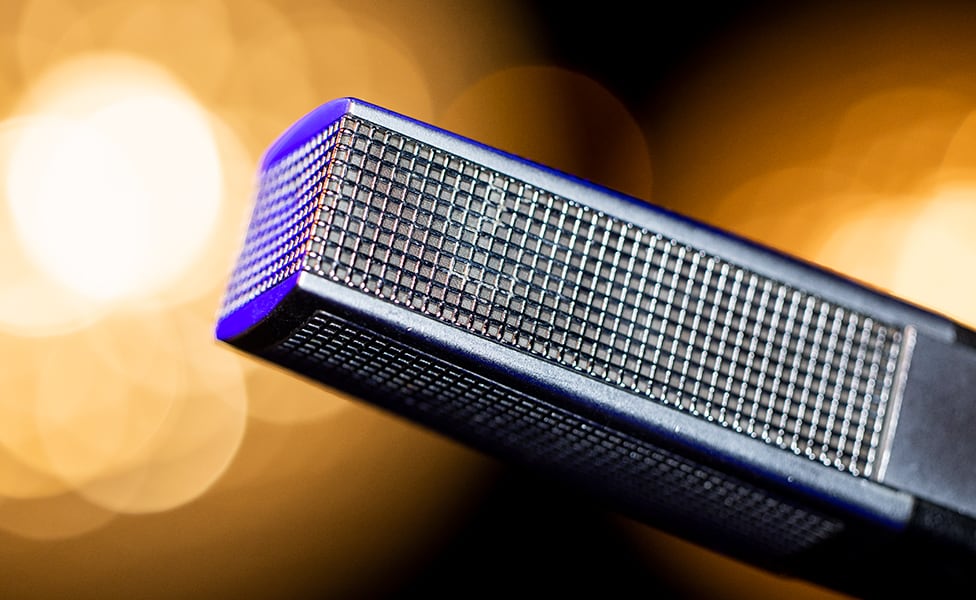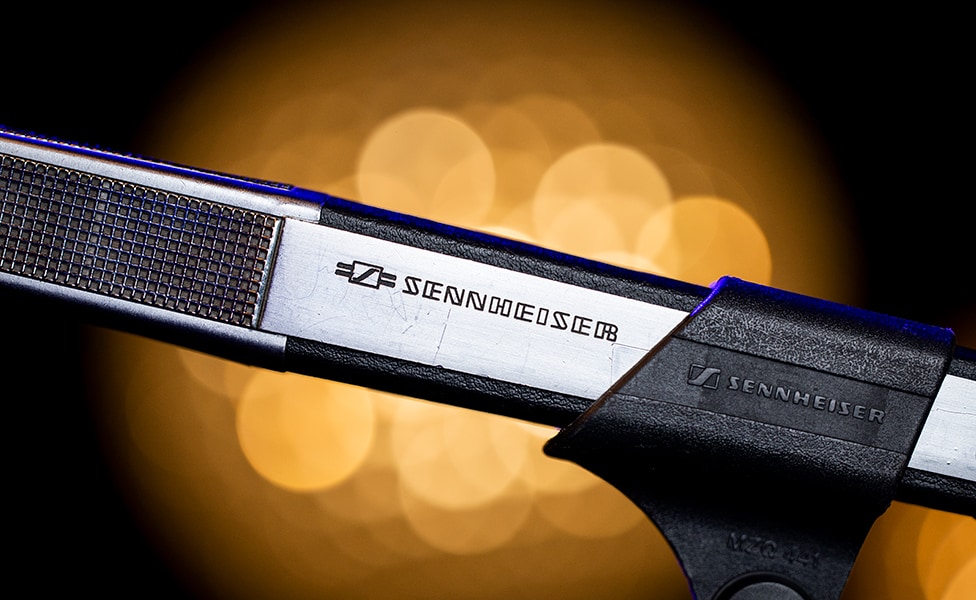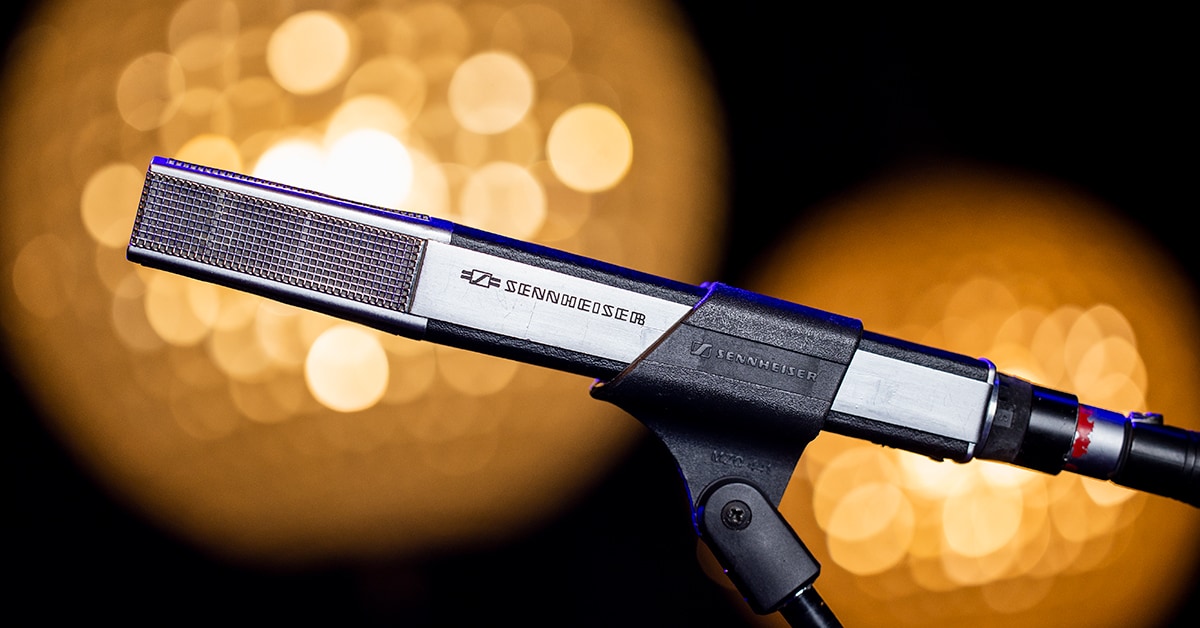Originally introduced in the summer of 1971, the Sennheiser MD 441-U is having a moment. Famously used on stage by legends like Stevie Nicks, David Bowie and Elton John, this one-of-a-kind, top-of-the-line—yet oft-overlooked—dynamic microphone is enjoying a modern resurgence, recently spotted with St. Vincent, Olivia Rodrigo and The War on Drugs, among a growing following of all types of musicians. Is it any wonder? Take a glance at its intriguingly angular, elongated design with its eye-catching five-sided metal grille that acts as a pop filter, and you’d be remiss if you didn’t do a double-take in curious admiration. Hold it in your hand, and its dual faux-leather sides juxtaposed with alternating metal flanks, along with its substantial, almost-rectangular frame, lend a perfect, uniquely luxurious grip to any singer (or engineer who has the pleasure of setting it up). Have a listen, and you’d be forgiven for mistaking its crystal-clear, shimmering high-end capture as that which could only from a condenser mic—it was designed to sound as close to one as a dynamic can get, and its design is impeccable. It’s acclaimed by many to be the best moving-coil dynamic mic ever made. Here’s why musicians and sound engineers of all stripes are flocking to the cult-classic Sennheiser MD 441-U, and why it’s the microphone you’re going to hear—and see—more and more of.
Until its recent renaissance in popularity, the MD 441-U had been something of a hidden gem, and a major factor for its relative obscurity is the sheer ubiquity of its hugely commercially successful sibling, the MD 421-II dynamic, which comes in at less than half the cost of the MD 441-U. But while the 421 is also seen on virtually everything (especially toms), the 441’s ability to capture such pristine high end, particularly with its hi-boost switch engaged, makes it an especially alluring choice for vocalists—as well as other instruments that benefit from the added sheen, like hi-hats, strings and guitar cabs. Its remarkable sensitivity of –55dB and hum-compensating coil catapult it to rarified air when it comes to dynamic microphones. That means less reliance on turning your mic pre’s gain knob clockwise (which can mean introducing unwanted hiss to your signal), and more playing to the strengths of a meticulously engineered world-class mic. With a loftier price tag than any other dynamic mic, the 441-U is unparalleled in its condenser-like tonality as well as its looks, whether on stage or in the studio. What’s the “U” in 441-U? It simply differentiates the XLR-ready MD 441-U from the DIN-compatible MD 441 N and the Tuchel plug-equipped MD 441-2, which were offered in its debut but have since been discontinued.

Every experienced engineer knows that after the quality of the performance and instrument itself, the next most important factor is the very beginning of signal flow—the microphone. If it sounds good going in, you’re setting yourself up with a solid foundation for what follows in the chain, and ultimately, the mix. That’s where the MD 441-U’s adjustable brilliance/hi-boost and 5-position bass roll-off switches come in handy. On its own, the 441’s frequency response curve is impressively flat, providing accurate audio reproduction. The 441’s hi-boost switch kicks its brilliant sonic character up a notch. When flipped on, it boosts frequencies above 2kHz to well-calculated varying extents, lending improved speech intelligibility and condenser-like shimmer on any instrument it graces—it can help a guitar slice through a busy mix. And, what makes the 441 a true chameleon of a microphone is its 5-position bass roll-off. Keep it at position 1 to maintain that low-end rumble on bass-heavy instruments, and roll it to the higher levels for progressively aggressive high-pass filtering. Positions 4 and 5 are particularly effective at cutting any “muddy” frequencies from the mix (in the 200–500Hz range), and below. If you’re miking hi-hats, for instance, position 5 is ideal for seizing that sought-after sparkle while isolating the rest of the kit. Lighten your load while mixing—and let 441 do its EQing magic upfront.
Speaking of isolation and optimizing your mix, the 441 boasts a near-textbook supercardioid polar pattern, bolstering immaculate off-axis rejection. This makes it ideal for singers with even the most effervescent stage presence and wandering habits, as it provides extra protection from feedback. It also makes MD 441-U a superb choice for snares, or any other drum—or for that matter, any onstage—component, where stamping out spillover from other instruments is of the essence. The same principle goes for recording as a band, where, depending on positioning, off-axis rejection can be essential for capturing a clean (let alone workable) sound. In addition to isolating your target instrument from other sound sources, the MD 441-U’s supercardioid polar pattern is one of the key facets that sets it apart from other industry-standard, multi-use dynamics, like the Shure SM57, SM58 and SM7B, as well as the Electro-Voice RE20.

The Sennheiser MD 441-U impresses even in some nonconventional ways for a dynamic of its class—bass instruments being a prime example. While it’s renowned for its prowess in capturing condenser-esque high end, its 30Hz–20kHz frequency range ensures it has just about all the bottom-end oomph the human ear could possibly hear. Experiment—put it on your kick drum at bass roll-off position 1, with the hi-boost, to get a subtly pronounced “click” of the beater hitting the batter head. Try the hi-boost with position 1 or 2 on a bass cab, too, and add some presence to your attack at the start of your signal chain. Toggle the brilliance boost switch off if that’s not your thing and prefer to leave off the highs from your bass mix. Test it alongside a DI (direct-injection) box, or one of your go-to bass mics you may already have in your arsenal, like a Shure BETA 52A or AKG D12, blend your signals and go stereo with it. Or, keep it simple and leave the very capable 441-U on its own to get real low and do all the heavy lifting. Regardless of how you use it—as an added benefit to its plethora of sonic qualities—an MD 441-U makes your rig look awesome, right out of the gate.
The MD 441-U sits atop the heap of dynamic mics in multiple respects, and for sound reason. It works great on everything in the frequency spectrum (and has the inspiring build quality and specs to back it up), it makes the monitor engineer’s job easier by mitigating feedback with its stellar off-axis rejection, its distinctive aesthetic speaks for itself loud and clear, and its résumé of iconic talent befits its righteous return to popularity. In situations where you seek the clarity of a condenser, but without the fragility—and often the added cost—that come with mics of that category, the Sennheiser MD 441-U is miles above the rest of its dynamic mic competition. Its revival was inevitable and long overdue. Described by Annie Clarke of St. Vincent as “The coolest … I never want to go back to anything else,” it’s easy to see (and hear) why the Sennheiser MD 441-U is here to stay.
.jpeg)






